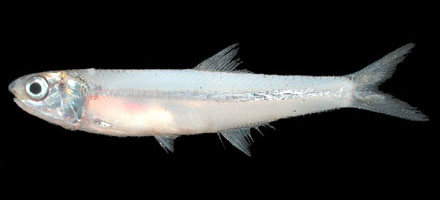
Stolephorus indicus, FRLM 30657, 6.3 cm SL
Stolephorus indicus (van Hasselt, 1823)
Indian anchovy
|
|
D 15 - 17; A 19 - 21; P1 15 - 17; P2 7; LGR 20 - 28. Body slender, almost round in cross-section; abdomen rounded with 3 to 5 small needle-like prepelvic scutes, but no postpelvic scutes; pelvic scute without spine; no predorsal spine-like scute; posterior tip of maxilla pointed, extending to or slightly beyond anterior border of preopercle; posterior border of preopercle convex and rounded; branches of preopercular canal extending onto opercle; isthmus muscle tapering and reaching to gill membrane; pelvic fins inserting well before vertical through dorsal fin origin; anal fin short, its origin situated at vertical through middle of dorsal fin base; caudal fin large and forked. Scales cycloid; longitudinal scale rows about 40. Color: body translucent, yellowish dorsally, with a broad silver stripe down entire flank. Size: commonly to 12 cm, maximum 15 cm in standard length. Distribution: widely distributed in Indo-Pacific from Red Sea and East African coasts to Samoa and Tahiti. Remarks: schooling fish found in coastal waters, often entering estuaries. Minor importance as food fish caught with purse seines, lift nets, and set nets. Fragile and unsuitable as a tuna baitfish.
|

 
|
|
